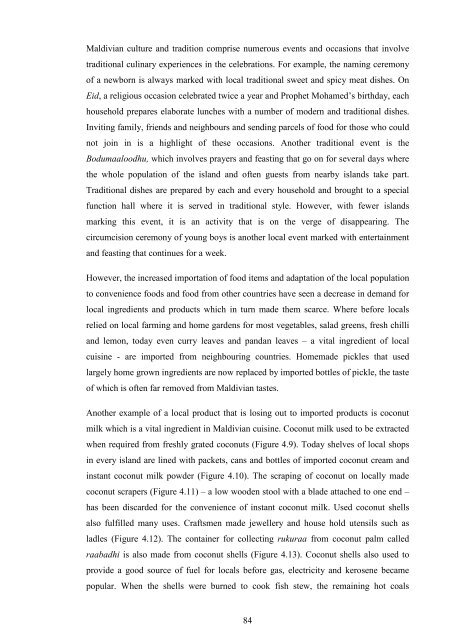The Role of Local Food in Maldives Tourism - Scholarly Commons ...
The Role of Local Food in Maldives Tourism - Scholarly Commons ...
The Role of Local Food in Maldives Tourism - Scholarly Commons ...
Create successful ePaper yourself
Turn your PDF publications into a flip-book with our unique Google optimized e-Paper software.
Maldivian culture and tradition comprise numerous events and occasions that <strong>in</strong>volve<br />
traditional cul<strong>in</strong>ary experiences <strong>in</strong> the celebrations. For example, the nam<strong>in</strong>g ceremony<br />
<strong>of</strong> a newborn is always marked with local traditional sweet and spicy meat dishes. On<br />
Eid, a religious occasion celebrated twice a year and Prophet Mohamed’s birthday, each<br />
household prepares elaborate lunches with a number <strong>of</strong> modern and traditional dishes.<br />
Invit<strong>in</strong>g family, friends and neighbours and send<strong>in</strong>g parcels <strong>of</strong> food for those who could<br />
not jo<strong>in</strong> <strong>in</strong> is a highlight <strong>of</strong> these occasions. Another traditional event is the<br />
Bodumaaloodhu, which <strong>in</strong>volves prayers and feast<strong>in</strong>g that go on for several days where<br />
the whole population <strong>of</strong> the island and <strong>of</strong>ten guests from nearby islands take part.<br />
Traditional dishes are prepared by each and every household and brought to a special<br />
function hall where it is served <strong>in</strong> traditional style. However, with fewer islands<br />
mark<strong>in</strong>g this event, it is an activity that is on the verge <strong>of</strong> disappear<strong>in</strong>g. <strong>The</strong><br />
circumcision ceremony <strong>of</strong> young boys is another local event marked with enterta<strong>in</strong>ment<br />
and feast<strong>in</strong>g that cont<strong>in</strong>ues for a week.<br />
However, the <strong>in</strong>creased importation <strong>of</strong> food items and adaptation <strong>of</strong> the local population<br />
to convenience foods and food from other countries have seen a decrease <strong>in</strong> demand for<br />
local <strong>in</strong>gredients and products which <strong>in</strong> turn made them scarce. Where before locals<br />
relied on local farm<strong>in</strong>g and home gardens for most vegetables, salad greens, fresh chilli<br />
and lemon, today even curry leaves and pandan leaves – a vital <strong>in</strong>gredient <strong>of</strong> local<br />
cuis<strong>in</strong>e - are imported from neighbour<strong>in</strong>g countries. Homemade pickles that used<br />
largely home grown <strong>in</strong>gredients are now replaced by imported bottles <strong>of</strong> pickle, the taste<br />
<strong>of</strong> which is <strong>of</strong>ten far removed from Maldivian tastes.<br />
Another example <strong>of</strong> a local product that is los<strong>in</strong>g out to imported products is coconut<br />
milk which is a vital <strong>in</strong>gredient <strong>in</strong> Maldivian cuis<strong>in</strong>e. Coconut milk used to be extracted<br />
when required from freshly grated coconuts (Figure 4.9). Today shelves <strong>of</strong> local shops<br />
<strong>in</strong> every island are l<strong>in</strong>ed with packets, cans and bottles <strong>of</strong> imported coconut cream and<br />
<strong>in</strong>stant coconut milk powder (Figure 4.10). <strong>The</strong> scrap<strong>in</strong>g <strong>of</strong> coconut on locally made<br />
coconut scrapers (Figure 4.11) – a low wooden stool with a blade attached to one end –<br />
has been discarded for the convenience <strong>of</strong> <strong>in</strong>stant coconut milk. Used coconut shells<br />
also fulfilled many uses. Craftsmen made jewellery and house hold utensils such as<br />
ladles (Figure 4.12). <strong>The</strong> conta<strong>in</strong>er for collect<strong>in</strong>g rukuraa from coconut palm called<br />
raabadhi is also made from coconut shells (Figure 4.13). Coconut shells also used to<br />
provide a good source <strong>of</strong> fuel for locals before gas, electricity and kerosene became<br />
popular. When the shells were burned to cook fish stew, the rema<strong>in</strong><strong>in</strong>g hot coals<br />
84

















